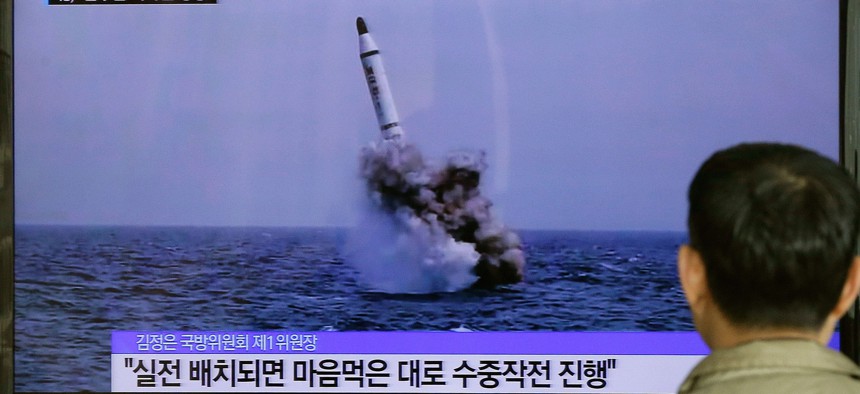
A South Korean man watches a TV news program showing North Korea's ballistic missile believed to have been launched from underwater, Saturday, May 9, 2015. Ahn Young-oon
North Korea’s Missile Test Is Less Impressive Than You Think
Photos of a May 9 sub-launch test indicate Pyongyang has a long way to go.
Kim Jong Un was all smiles and cigars in photos that showed a surprise May 9 test of a submarine launched ballistic missile (SLBM) in the waters off North Korea. But there was less to the dictator’s photo op than meets the eye.
If North Korea could perfect this technology, it would be an impressive and dangerous new capability. Missiles launched from subs are traditionally “second strike” weapons. They are harder to detect and thus harder to take out in an initial attack. So this system—once operational—could give North Korea the ability to respond to an attack, whether conventional or nuclear, with a nuclear strike. In a crisis, that could stay the hand of South Korea, the United States, or another adversary. It could also be used in a surprise first strike. The photos, predictably, produced a surfeit of officials and experts ringing alarm bells.
Relax. North Korea has a very long way to go.
This elaborate photo celebration appears to have been staged at an “ejection test,” designed to demonstrate the ability of a sub to shoot up a missile from under the water, have it ignite, and begin flight.
The missile appears to have gone about 100 or 150 meters, according to South Korean officials, about the length of a football field. That sub would have to be awfully close to its target to hit anything.
The photos of Kim watching the missile pop up through the surface could be enhanced, but they could well be genuine. Regardless, there were no photos released of the missile plopping back into the ocean a few seconds later. They showed the pop but not the plop.
Furthermore, as Tyler Rogoway notes in his piece for Foxtrot Alpha, “Just because the missile shown in the photos appeared to safely clear the water and climbed out through low-altitude doesn’t mean that the missile is fully capable of traveling thousands of miles to a specific target.”
He’s right. Putting a missile up is actually easier than bringing it’s warhead back down and on target. This requires sophisticated guidance, staging, exquisite reliability and, most importantly, a re-entry vehicle that can survive the heat, vibrations and gravitational stresses of coming back into the atmosphere and continuing all the way to a successful strike. North Korea has not demonstrated or tested any of these abilities.
“North Korea’s ability to manufacture such a precise instrument,” wrote Rogoway, “that can survive long periods installed atop a missile, housed in submarine, and then endure the rigors of a launching and atmospheric re-entry remains questionable at best.”
Further, though North Korea seems to have made some progress on reducing the size of its tested nuclear weapon, there is no public evidence that it has shrunk the device enough to fit it into the warhead of a missile.
“The miniaturization of a nuclear warhead,” says Gene Habiger, a retired general who once led the U.S. Strategic Command, “is probably the most significant challenge that any proliferant would have to face." Habiger notes that it took the United States six to eight years of intensive engineering and testing to get our weapons down to warhead size.
To put this in perspective, the United States today has 1,152 hydrogen bomb warheads on sub-launched missiles that can land within the area of a football field almost anywhere on Earth in under 30 minutes. It also fields 450 similar weapons on long-range land-based ballistic missiles.
(See also: China Says North Korea Has More Nukes Than the US Thought)
North Korea has enough material for perhaps six atomic bombs, maybe more, but there is no available evidence that it has operationalized any weapons.
North Korea plays its weak hand very well. It puts on an impressive show with ancient technology. The sub in this test appears to be based on the Soviet Golf class that entered service in 1958. The missile itself seems to be a 1970s Soviet system. Claims by some South Korean officials that Kim could develop a real SLBM within three to five years overestimate the ability of even the clever North Koreans to stretch these mid-20th-century technologies.
Even if the alarmists are correct, this missile can fly no more than 1,500 miles. That means, as nuclear expert Jeffrey Lewis has noted, the North Koreans would have to sail their sub 60 to 90 days to get within range of the continental United States, during which time it would run a very high risk of detection and destruction.
Kim Jong Un would be much better off having FedEx deliver the warhead. That, at least, would ensure it would get there within three days.
NEXT STORY: Tomorrow’s Small Wars Won’t Just Be Land Wars




